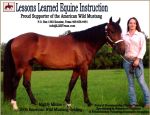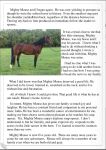I was working on the TMP website today, updating things and fixing bugs. I came across our page “Clarification of My Position” that contains my speech prepared for the National Wild Horse & Burro Advisory Board Meeting, Reno, NV, in December 2009. As most of you know, I did not make it to that meeting. Texas hadn’t had snow in years, but it certainly came in that week.
Today, I found myself re-reading the statement I had prepared, and I realized that it was just as pertinent now as it was then. This is a very sad realization. So, in the interest of putting it out there and trying to reconcile some of the differences we see so much of still, here is that statement again. MF*T*
I do not affiliate myself with any one advocacy group or organization at this time because I do not personally agree with any one of the groups and organizations that have approached me with this proposition. I do not feel as though it would be fair to the wild horses and burros to devote any of my energies whatsoever toward the non-efficient and ill-fated blaming sessions that are so common in this campaign. In the end, the wild horses and burros are the ones who ultimately suffer. I also do not feel as though my participation from an internal standpoint would be beneficial to any party involved based on the knowledge of conflict of opinions between myself and other members at this time. The energies put forth should be directed at the ultimate goal, not toward conflict of any kind. I do not affiliate myself with any government agency or organization at this time for these same reasons.
However, I do feel as though the path to a viable and clear solution involves all of the voices among the sides of this situation. Each person has a voice, and each voice should be heard. In those voices, we can glean the information we need to come to the best possible conclusion for the wild horses and burros. We can use this information along with the information we have readily available to us to promote better management options and cohabitation through compromise and communication.
I agree with the BLM’s mandate of protection and management of the wild horses and burros due to the need to maintain a balance of the ecological systems wherein they reside through population control. I do not agree with the methods currently in place to facilitate that mandate. To members of the BLM, the National Wild Horse and Burro Program, the Advisory Board, and to all other members of their affiliates, I put forth the following statements:
•No horse or burro should ever be struck with any object in an attempt to “make” him perform an intended task. He is a sentient being. He should not be struck for any reason by the hands of man. There are other ways to communicate without violence. The wild horses and burros have shown and taught mankind the language of Equus. It was only discovered by those members of mankind with an open mind to actually stop and see the fascinating methods of communication among the different members of the herds. Through this language, members speak as clearly as you and I are speaking now and its discovery has brought about an entirely new form of interspecies communication called Natural Horsemanship.
•No horse or burro should ever be pushed to step on or trample another member of his herd in an attempt to “speed things along”. Again, these are living and breathing creatures who do feel pain and who do feel emotion. There is no time schedule whose strictness is important enough that it causes injury or death to another creature simply because of man’s impatience or quest for promptness, efficiency or budget constraints. I ask you to place yourself in his place for just a moment. Imagine that you were forced to harm a member of your own family. There is no difference simply because we are human. These animals have a family bond that is unlike no other. Just because it is not understood by some members of mankind does not mean that it is any less real.
•No horse or burro should ever be placed in a position, physically, mentally or emotionally, where he will be forced to resort to fight or flight instincts. Mankind seems to forget somewhere along the path that we are not the rulers of any universe; we are the cohabitants of this universe. We do not have the right to force our hand on another soul with the misguided notion that we are somehow superior. Let us not forget that it is only through the blood, sweat, and sacrifice of these animals that we are in this very location today. Without their help, Lewis and Clark might’ve never made it to this range and we could all still be in the prehistoric era of our evolutionary timeline.
I agree with the various advocacy groups and organizations whose mission statements correlate with the mandate of better protection and management of wild horses and burros. I do not agree with the extremist point of view mission statements, nor do I agree with the opinion of letting nature take its course. To members of these groups, I put forth the following statements:
•If you want protection for the wild horses and burros, understand that with that protection comes management. You cannot have one without the other. Without protection, they are vulnerable to the cruelties of mankind’s lower and colder hearted members who would exploit these magnificent animals for their own profit and gain. In the process, the wild horses and burros would be subjected to unimaginable cruelties and inhumanities. With protection, they are not subjected to this situation at the hands of these members of society. They are however subjected to lesser cruelties and inhumanities by their managers. This is where we need compromise the most, from both sides.
•The facts are evident at this point in time that we cannot allow nature to take its course where the wild horses and burros are concerned due to the facts that mankind has altered the course of nature with its continual evolutionary processes and growth towards cleaner and brighter futures for our children and grandchildren, among other causes. As a result, the course that nature would have originally taken no longer exists. Therefore, the argument of simply letting nature take its course is not a valid position. Were this allowed to take place, the congregation of wild horses and burros would surely become extinct in a matter of a few decades. Furthermore, this process would be one of a greater pain and suffering that we see now at the hands of their managers.
•Remember that even though the wild horses and burros are our passion and point of interest, they are not the only integral parts of the natural system which they inhabit. There are other members of this ecological system who are equally as important as those members who have stolen our hearts. Just because the horses and burros are the sources of our passions does not give them immunity from the imbalance that their existence sometimes contributes to.
•If you start with misinformation, realize the error of your ways and work to correct them. Do not allow pride to cloud your judgment resulting in a non-factually based proposal. Find all the information possible to make your decision one that comes from a well informed standpoint. Do not stop with just the information needed to support a decision that best benefits you, individually or as a group. Remember that you are not the ones in danger, and that your ignorance of all information available does not physically cause you harm. The wild horses and burros are the ones who pay your debt of ignorance.
Finally, to all parties involved, I put forth the following statement:
•Where mankind is involved so shall there be error. This is inevitable. Therefore, I take this opportunity to remind you all of the fact that we are all human; we will all make mistakes. Our ultimate goal in any quest should be that we make the best decisions possible with all of the information we can gather in order to effect the end result with the least amount of adverse reactions possible. There are those among us today who have made the statement over and over of how they would have performed in a more suitable manner than the ones next to them if only they had been given the chance. This is usually a statement made with great pride. I say to you here and now: it is only with humility in our hearts that we can listen with an open mind to the plight of another and take that plight to the next step of positive action. Let he who has no sin cast the first stone. But let he who has humility in his heart be the one to wipe away the tears of the one who was struck with humility and with a kindness that does not expect any reward in return.
I do not disagree 100 percent with the BLM’s officials, personnel, or their mandates. I do not disagree 100 percent with the advocacy groups, organizations, or the individuals. I only agree with those members of the aforementioned persons who are willing to look at all sides of the information and who work toward the common goal of better protection and management of the wild horses and burros diplomatically. It is only through this cooperation that we can attain that goal. There is no completely right answer. There is no completely wrong answer. The job that we have all signed on to perform is to come to the best possible solution by taking the best points from the many answers and the vastness of information available and putting them forth into positive actions.
Because of my position, I have been accused of “riding the fence” by members of both sides of this argument. I put forth the consideration that there are many sides to this argument, not just two. Even among those of us present, there are different views among the individuals involved. You cannot say that your views are exactly the same as the person sitting next to you, nor could they say the same. There is nothing wrong with this. There is everything right with this. The key to the puzzle is how we go about using all of the views toward our common goal. The answer is that we use all of the views productively and with an attitude of acceptance. Accept that we are not going to get our way every time, and that this is ok. This is not a game. This is reality. This is the reality of lives, literally lives at stake, dependent upon our ability to reconcile our differences, work together, and compromise for the best possible outcome.
I am by no means without guilt in this situation nor do I proclaim to be such. I too have participated in the very actions that I speak out against in this statement in the respect of the “blaming game”. For that, I do apologize and ask forgiveness to all of those whom I have affected with these behaviors. However, I do not feel that the mistakes of mankind should be debts paid by innocent creatures.
It is not my wish or intent that this statement is taken as an insult or in a condescending manner. It is not meant in any derogatory way. My only wish is that we put aside our differences and focus on the reality of the problem at hand, and realize that this is the only problem worth our time and energy where this campaign is concerned. With this approach, I truly believe that we can help our beloved mustangs and burros, and that our children will not only have cleaner energy and brighter futures but will have the opportunity to look out across a rangeland plentiful with the Spirit of the West.
*Update: Over the course of the past couple of years, I have in fact become an ally to a specific advocacy group and its affiliates. The Alliance of Wild Horse Advocates (AOWHO) is a group that has stolen my heart and much of my time. Their program – the Least Resistance Training Concepts (LRTC) Wild Horse Mentors (WHM) – is one of inestimable value. As most of you know, I am a Natural Horsemanship / Equus Trainer and Instructor. I firmly believe that manners are a two way street; if you treat your horse with respect, he will respect you. LRTC WHM are of the same belief system. More specifically, they’re goals are all about the American Wild Mustang. Their Mission Statement says it all: “To ensure appropriate and safe homes for adopted animals and a satisfying experience for adopters by providing pertinent education and mentoring assistance, and to develop programs that preserve viable herds on the range.” The group and it’s allies have received quite a bit of criticism over the years. Specifically, they have been wrongly “labeled” as BLM sympathizers, “on the BLM payroll”, etc. I find this to be very disheartening. The lives of Mustangs that have been saved over the years through this program can’t be truly counted. In order to accomplish the saving of these lives, certain relationships and cooperation with BLM / WH&B were required. What I don’t understand is how anyone could claim that AOWHO, LRTC, or WHM is in the wrong for doing so. LIVES WERE SAVED. ‘NUFF SAID. MF*T*

















